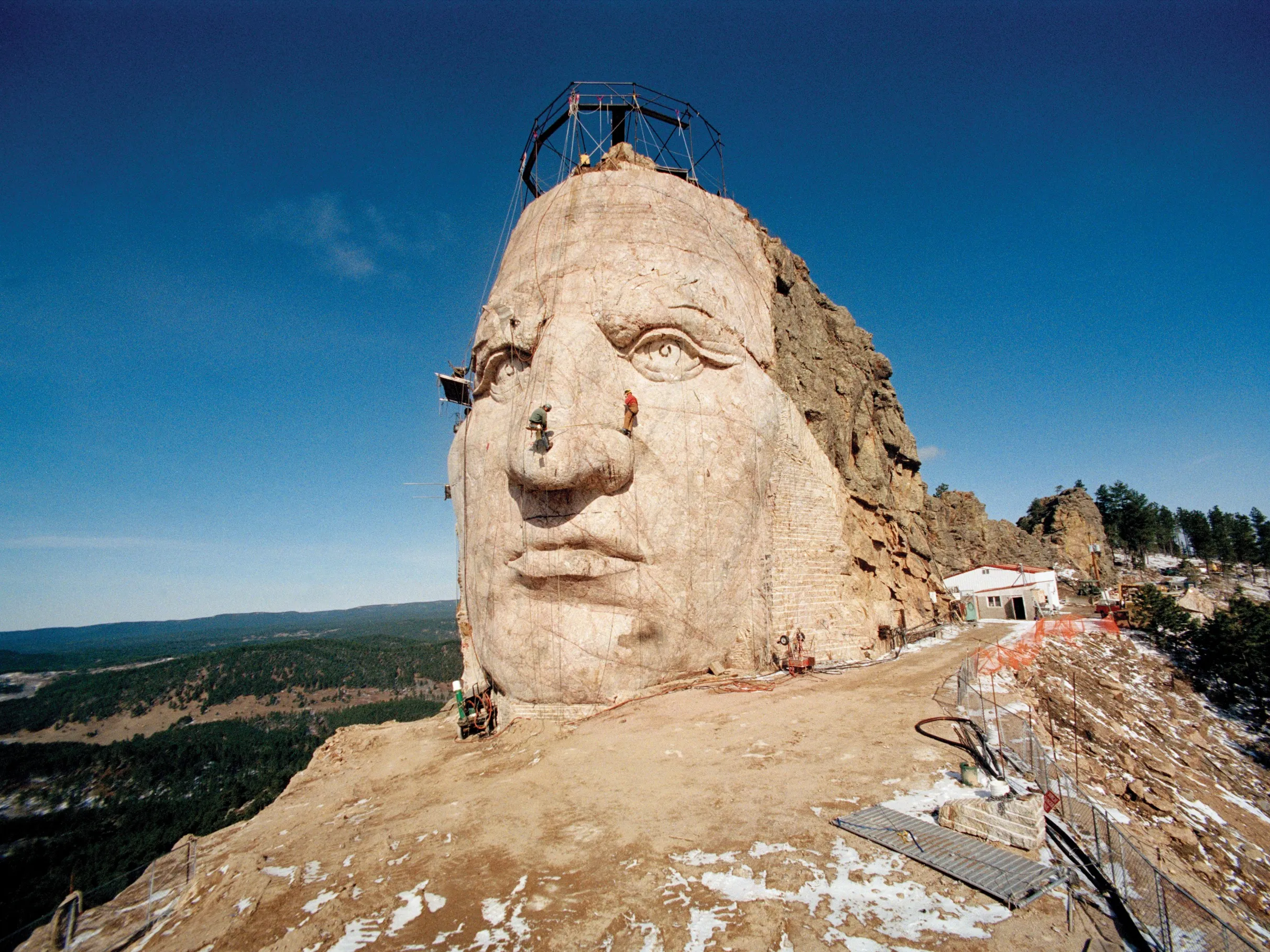The Crazy Horse Memorial is a tribute to Crazy Horse, a Lakota War leader, located in the Black Hills of South Dakota’s Custer City, only 17 miles away from Mount Rushmore.
It is an in-progress mountain carving that began work in 1948 by Polish-American sculptor Korczak Ziolkowski, who is also the sculptor who was in charge of the Mount Rushmore carvings.
If or when this monument is completed, it will be the largest mountain carving in South Dakota and the world as well as the second largest monument in the world.
The intent is to create a massive statue that will be 641 feet long and 563 feet high, which is massive in comparison to the heads at Mount Rushmore which are 60 feet high.
At completion, the sculpture will depict Crazy Horse on his horse, pointing to his tribal land below — which the Oglala sub-tribe he led considered sacred.
At present, the only finished part of the sculpture is the 87½-foot-tall Crazy Horse face, which was carved by workers in 1998.
Since then, the focus of the workers has been on thinning the remaining mountain to form the 219-foot-high horse’s head and finishing work on the outstretched arm and hand of Crazy Horse along with the horse's mane.
Most of the work that will continue on this area of the mountain will be done by hand.

Lakota chief Henry Standing Bear originally petitioned Ziolkowski to create the memorial in 1939, believing that honoring Crazy Horse with a monument was imperative.
He has been documented as writing to him that “My fellow chiefs and I would like the white man to know that the red man has great heroes, too”.
He felt very passionately about the project, having traded his 900 acres of land for the desolate mountain with the Department of Interior, and also continuously rejecting federal funding in utter aversion to government involvement.
Since Korczak Ziolkowski’s death in 1982, the Crazy Horse Memorial Foundation has been run by his daughter Monique.
Three members of the Ziolkowski family have been continuing work on the project.
The memorial is funded entirely by private donations and admission sales from tourists who come to visit the memorial.
While the cost of completing the monument has not been estimated, the foundation has raised over 19 million dollars to finance various stages of the mountain carving.
In addition to the mountain carving, Crazy Horse Memorial features an Indian Museum of North America and a Native American Educational & Cultural Center, which provides educational and cultural programming.
The memorial is quite popular, hosting between 1 and 1½ million visitors a year.
Additionally, there is a laser-light show called “Legends in Light” which does storytelling at night by projecting onto the mountain carving from Memorial Day weekend through the end of September.
During Crazy Horse’s lifetime, the lifestyles and residencies of Native Americans were under attack due to American expansion to the west.
Having participated in a number of battles against American forces who were brutally attempting to take over their land, Crazy Horse was fiercely protective of his people and ancestral land.
He is most remembered for leading the Lakota in the Battle of Little Bighorn (or Custer’s Last Stand) in 1876 against Commander George Armstrong Custer’s Seventh U.S. Cavalry battalion whose outcome left all 280 U.S. soldiers and nine officers dead.
This battle occurred because the U.S. Government was trying to force the Lakotas onto reservations. The Crazy Horse Memorial is actually located close to where this battle took place.
After this battle, the U.S. doubled down on its brutality against the Native American population, deploying more and more soldiers to the area.
Ultimately, many of the Native Americans who were forced to move died of starvation or because of the elements.
As a result, Crazy Horse was forced to negotiate for a truce and traveled to Fort Robinson in September of 1877.
However, Crazy Horse’s translator misinterpreted his words during the peace talks, leading the commanding officers to attempt to imprison him.
Crazy Horse then drew his knife and a guard bayoneted him to death.
We think this memorial is significant because it is rare for Native American figures to be famous or well-known.
The memorial gets a lot of visitors, meaning Crazy Horse’s name is relatively recognized.
Additionally, Crazy Horse was a war leader who fought on the opposite side of the U.S. government in a number of battles.
Despite this opposition, he has a memorial that receives a significant amount of visitation.
Furthermore, its proximity to Mount Rushmore and the fact that Crazy Horse’s head is larger than the heads at Mount Rushmore shows that the design was an attempt to show the greatness of Crazy Horse.
This is uncommon with regards to comparisons between monuments to people of color and to white people, as monuments to white people are usually larger.
The Crazy Horse Memorial is subject to a lot of controversy, with many negative feelings regarding it from the side of the Lakota.
Many of the Lakota feel that the Crazy Horse name has been exploited to generate money for the Ziolkowski family, who have built a complex of visitor centers and souvenir shops, which earn the descendants of Korczak Ziolkowski millions of dollars annually.
They feel that it is a privatized monument that is exploiting the tourist rush to Mount Rushmore, since it is so close.
Additionally, the descendants of Crazy Horse feel that Henry Standing Bear had no right to ask Korczak Ziolkowski to create the mountain carving in the first place.
According to Lakota culture, family members of Crazy Horse should have been asked to give permission before the decision was made, but they weren’t asked to approve of the decision.
Furthermore, many of them feel that their culture was desecrated because their sacred Black Hills where their burial grounds are were carved.
Google Maps Link
